Representation of Sumerian Elites Detected in the Crespi Gold Tablets
It is becoming increasingly clear that the Sumerians had established a colony in South America called Kuga-Ki. Kuga-Ki was the “Tin Land of the West” or the “Sunset Land”, in Sumerian inscriptions.

Sumerians in South America
The Sumerians left several inscribed artifacts in South America. The Pokotia monument and the Fuente Magna bowl were written in linear Sumerian. The fact that the writing existed on the Fuente Magna Bowl, and Pokotia monument in Sumerian, and the identification of Sumerian place names on the Altiplano suggest that Ecuador to Bolivia, was Kuga-Ki.
Researchers have suggested that some of the Gold tablets in the Crespi Collection may also be written in linear Sumerian. Father Carlos Crespi Croci collected thousands of artifacts that he claimed were found by local Indians in caves of Ecuador. Father Crespi was born in Milan, Italy, in 1891 and died in 1982.
There are supposedly many engraved tablets in the Crespi Collection. Erich von Daniken in Chariots of the Gods , was the first researcher to bring to our attention some of the ancient tablets in the Crespi Collection.
I have wanted to read the Crespi Tablets for years. But I avoided attempting to read the Tablets because all we have are photographs of them. The photographs of the Tablets often lack a full representation of the inscriptions or the lighting is poor, so it is difficult to make out the signs.
Even though this is the case, I will attempt to read some of the Crespi Tablets, because they may give us more insight into the culture and religion of the Sumerians at Kuga-Ki. I used Ball and Halloran Sumerian word-lists to read the Crespi Metal Tablets.
Reading of the Available Crespi Tablets
In my book Ancient Scripts in South America , I discuss the Sumerian symbols found on the textiles of Inca Sagas. In the Guaman Poma we find many Inca rulers called Saga or Capac that have Proto-Sumerians signs similar to the signs in the textile worn by the Ecuadorean elite from the Crespi Collection.

Crespi Gold Plate showing a robed shaman (Left). Manco Capac Book Illustration (Right). (Author Provided)
The names of the Crespi elites are either found on the textile hanging from the waist of the Shaman or the flaps hanging down from the headband of the Chief.
There are two Shaman in the Crespi Tablets. The first Shaman holds a staff in his left hand. The right hand is held high as if greeting someone. The name of this Shaman is on the textile hanging from his waist.
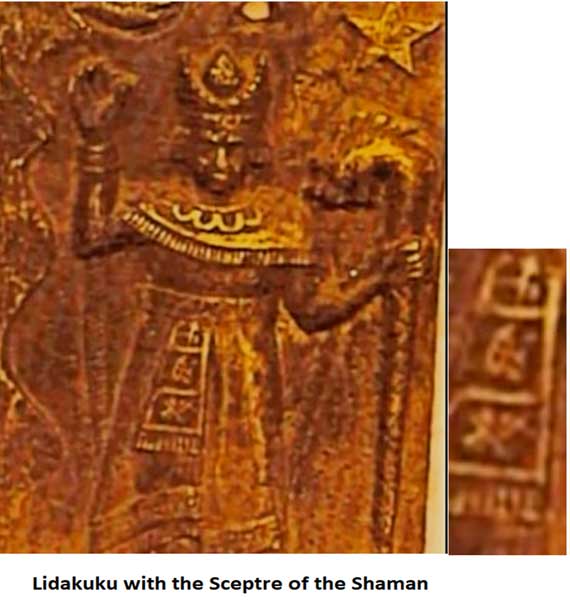
Crespi Gold tablet with shaman, detail of waist textile. (Author Provided)
The Sumerian signs are in the first three panels of the textile. The transliterations of the signs are the following:
1) Lu pa Mash. 2) Lidakuku. 3) Mash mi ta.
The translation is “1) The man [with] the Sceptre of the Shaman. 2) Lidakuku. 3) The Shaman [Lidakuku] is bound to the Oracle”. From this tablet we learn that the Shaman carried a staff as a symbol of authority.
A Sumerian Chief in the Tablets?
The next Crespi Tablet has a man sitting on a throne, with a stylus in his hands and an inscribed document on his lap. The man wears a headband with flaps hanging down from the headband. This elite wears feathers in his hair.

Crespi Gold Plate of Chief. (Author Provided)
There are four panels containing inscriptions on the flap of the headband. These panels contain the name of this Chief. From top to bottom we read: 1) Mi mi, 2) Bi, 3) Ga, 4) Lu. The signs on the headband flap, says “(1-2)Mimibi, 3[the]Chief 4) esteem”, or “Mimibi the Esteemed Chief”.
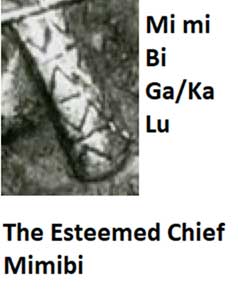
Detail of Crespi Gold Plate of Chief. (Author Provided)
There is a written document on Mimibi’s lap. There are three columns of signs. They are:
1) a i mi mash, 2) i i lu li mi I, 3) Mash.
We read the following “1) The strong powerful oracle [of the] Shaman, 2) The glistening Oracle witnesses [the man’s rise]. 3) [This] Divine Decree”.
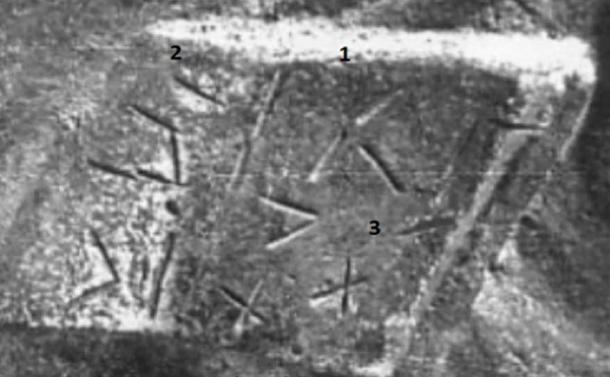
Detail of tablet in the hands of the elite. (Author Provided)
Transcription: 1) The strong powerful (man) is the oracle of the Shaman. 2) Witness the powerful man’s rise. The glistening oracle [is its] withness. 3) [This is a] Divine Decree.
A Third Shaman in the Collection
There is a third Shaman. This Shaman wears a textile hanging from his waist. And he is standing on a floor with panels containing inscriptions. Reading the signs on the textile from top to bottom we read:
1) Mash, 2) Ta I lu se, 3) ta se, 4) me i.
The translation is 1) Shaman, 2) Tailuse, 3) binds the patron, 4) the oracle rise, or “The Shaman Tailuse binds the patron to the oracle rise [it up]”.
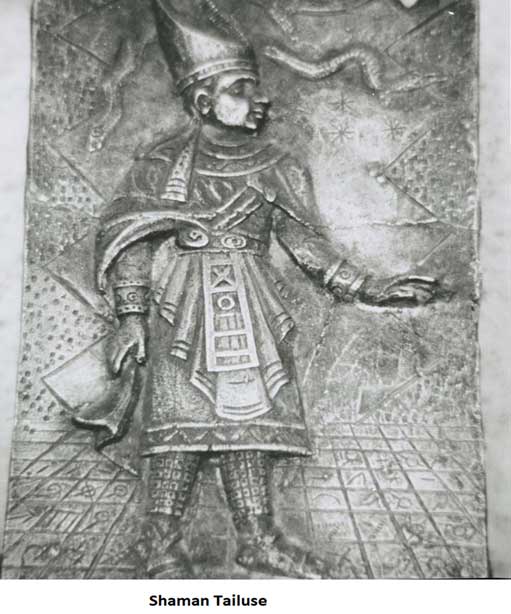
Crespi metal tablet with shaman. (Author provided)
At the feet of Shaman Tailuse were a number of inscriptions. The inscriptions are on the right and left sides of Tailuse.
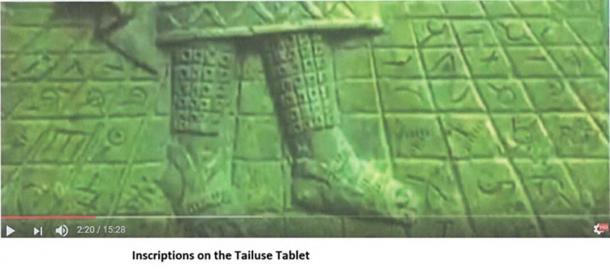
Detail of inscriptions on the Tailuse tablet. (You tube Screenshot, Author provided)
Reading the inscriptions on the right side of the Tailuse Tablet we see in transliteration, reading the inscription from right to left top to bottom beginning with the second column of signs we see:
2. Ta u ta. i a li ta li
3. i Mash ta I I ta i a a mi i u i
4. Ta mi li u i li su li i ta
5. a i a se jo Mash a a i po
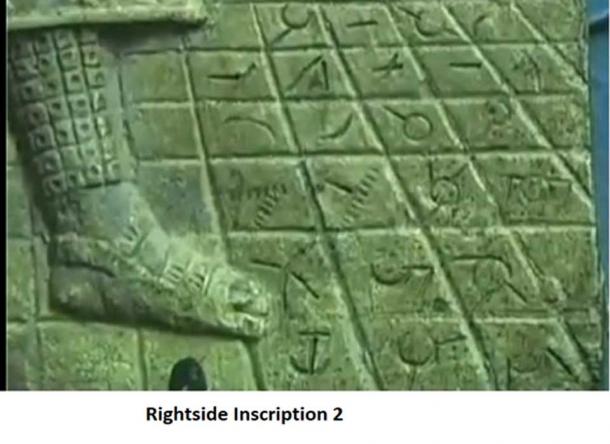
Detail of inscriptions on the Tailuse tablet. (You tube Screenshot, Author provided)
The translation of the rightside inscription of Tailuse says:
“…..2) Open [up] amazing Character to witness [a] strong luster and leave open tru[th]. 3) Witness the Shaman [Tailuse] to leave and open [up] a Spell [from] the Strong Father of the Oracle. Witness the powerful (man’s) rise. 4) Entrust the glistening Oracle [of] the powerful man; In order to make libation[s]. Witness [its] shine. Open [up] the Spell. Witness [its] open.5) The Father [Tailuse] to witness strength and increase benefit(s) [for all]. The Shaman [Tailuse] is a strong Father [of the] Oracle to witness purity”.
Under the right foot of Tailuse we see two panels with signs. They read:
1) Se jo ta Mash. 2) Lu ki.
The translation of these signs reads: “1) The patron [Tailuse] to benefit [from] and stand by the Oracle. 2) This man is Noble”.
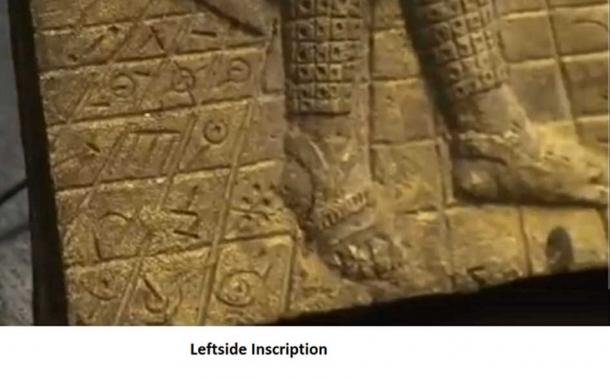
Detail of inscriptions on the Tailuse tablet. (You tube Screenshot, Author provided)
The transliteration of the inscriptions on the left side of the Tailuse Tablet say:
1. Ta I ki ta li i i u i
2. I ta Mash du I ki
3. Mi ki mi i
The translation of the left side of the Tailuse Tablet reveals, “1) Bind the witness [Tailuse] to the Cult; the progenitor of many people [Tailuse] to rise [up] a shining Spell. A spell to nourish exaltation. (2) Rise up the character of the Shaman’s Goodness. Witness [its] rise. 3) The divine decree to rise [up] a phenomenal area of the deity’s word”.
Female Representations and Text
Another interesting Crespi Tablet has two women, with inscriptions of either side of the females. The inscriptions on the left side of the tablet are dark and I have not tried to decipher the text.
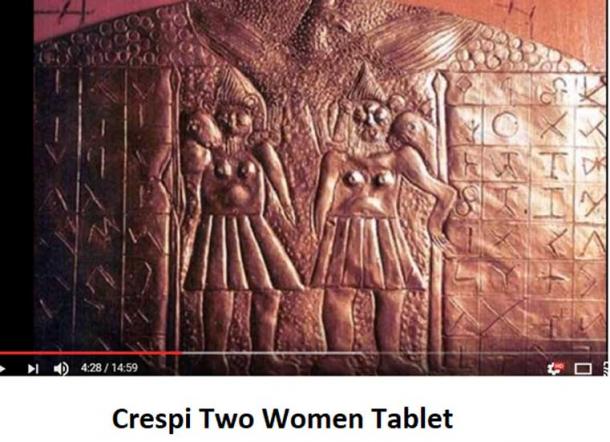
Crespi Two women tablet (Youtube Screenshot, Author provided)
Related Post
A shocking documentary proves that mermaids do exist
SHOCKING Revelation: Thuya, Mother of Queen Tiye, Was the Grandmother of Akhenaten and Tutankhamun—What Ancient Egyptian Secrets Did She Leave Behind?
Breaking News: Astonishing Discoveries at Karahan Tepe Confirm an Extraterrestrial Civilization is Hiding on Earth, and NO ONE Knows!
Breaking News: Researchers FINALLY Discover U.S. Navy Flight 19 After 75 Years Lost in the Bermuda Triangle!
NASA’s Secret Investigation: Uncovering the Astonishing Mystery of the UFO Crash on the Mountain!
Explosive UFO Docs LEAKED: Startling Proof That Aliens Ruled Ancient Egypt!